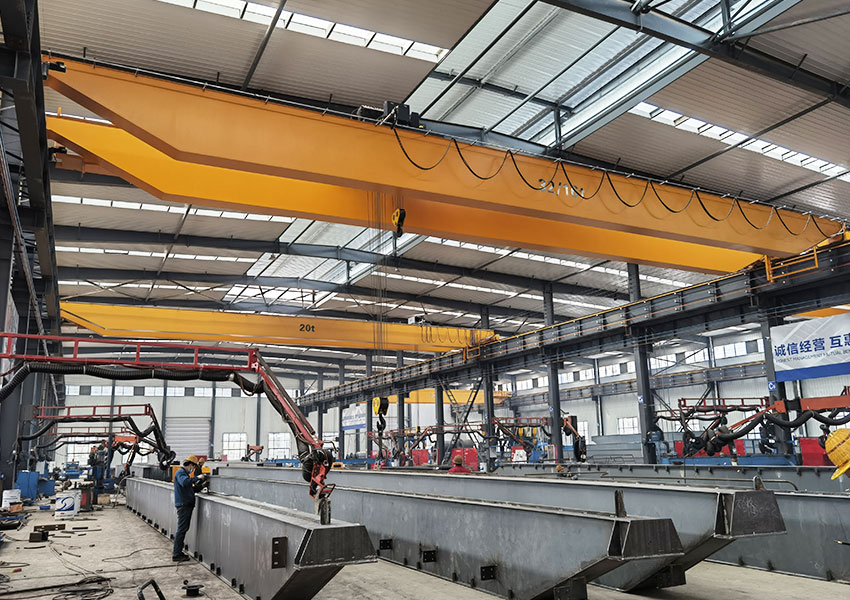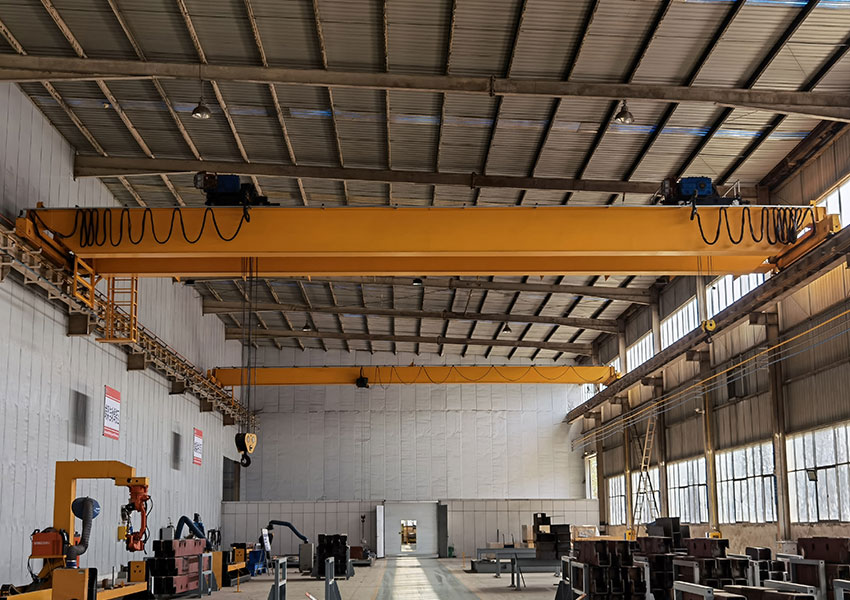When selecting a bridge crane for your business, it’s essential to strike a delicate balance between price and performance. A bridge crane is a significant investment that can have a profound impact on your operations, so it’s critical to ensure that you’re getting both value and efficiency out of your purchase. While price is a determining factor, performance factors such as lifting capacity, speed, safety features, and durability should also influence your decision. In this article, we’ll explore how to evaluate the balance between price and performance when purchasing a bridge crane.

Understanding Bridge Cranes and Their Applications
Bridge cranes, also known as overhead cranes, are vital pieces of equipment used in various industries for lifting and moving heavy loads across a defined path. These cranes are commonly used in warehouses, factories, ports, and construction sites. They consist of a bridge structure that spans a pair of rails or tracks and supports a hoisting mechanism that can lift, lower, and move loads horizontally across the work area.
The design of a bridge crane is inherently flexible, allowing for customization based on the needs of specific applications. Whether you’re lifting steel beams in a factory or moving goods in a warehouse, bridge cranes can be tailored to meet the unique demands of your business.
Key Factors Affecting the Price of a Bridge Crane
Before diving into how price and performance interact, let’s explore the key factors that influence the bridge crane price.
-
Lifting Capacity
The lifting capacity of a bridge crane is one of the primary factors that influences its price. Cranes designed for heavier loads require more robust construction materials, larger motors, and enhanced lifting mechanisms. As you increase the lifting capacity, the price tends to rise proportionally. -
Span Length
The span length refers to the distance the crane bridge covers, from one side of the building to the other. A longer span requires more materials and engineering, which in turn increases the cost. If your facility needs to cover a large area with the crane, this will directly impact the price. -
Speed and Performance
The speed of the crane’s hoist and trolley can affect the overall performance of your operations. Cranes with faster lifting speeds and more precise controls tend to come at a higher cost. However, investing in a faster crane can also boost your productivity, so the price increase might be justified depending on your operational needs. -
Customization and Features
Custom features such as explosion-proof designs, special control systems, or advanced safety features can add to the price of a bridge crane. Cranes built for specific industries, such as chemical plants or steel mills, require special materials and components that will increase their price. -
Duty Class
Bridge cranes are classified according to their work duty or how much stress they can handle. For example, cranes used for frequent lifting of heavy loads will require more durable components than light duty overhead cranes used for occasional lifting. This durability comes at a higher cost but can contribute significantly to the crane’s lifespan. -
Control System
The control system, which can range from basic manual controls to advanced computer-controlled systems, also affects the price. Wireless controls, remote control systems, and automated systems tend to increase the cost but offer enhanced convenience and accuracy in operation.

Performance Factors to Consider
Now, let’s turn our focus to the performance aspects of bridge cranes that will guide you in assessing their value for your specific needs.
-
Lifting Capacity and Frequency of Use
The lifting capacity you require depends on the nature of your work. For industries dealing with heavy equipment or materials, a crane with a higher lifting capacity is essential. However, higher capacity cranes can increase both upfront costs and maintenance expenses. Therefore, balancing the lifting capacity with the frequency of use is crucial. A higher capacity crane such as 100 ton bridge crane might be ideal for operations requiring frequent heavy lifting, but if your lifting needs are sporadic, a more moderate capacity crane might be a better investment. -
Speed and Precision
The speed of operation can significantly influence productivity, but it also impacts the cost. High-speed cranes are typically more expensive due to the advanced mechanisms required for fast movement and precise load control. If you’re working in an environment where fast turnaround times are essential, a crane with higher speed and precise control may justify the higher price. However, if your operations are less time-sensitive, you might opt for a crane with a slower, more economical speed. -
Durability and Maintenance Costs
A key performance factor to consider is the crane’s durability. A bridge crane that can withstand heavy use and extreme conditions will offer a higher return on investment in the long run. On the other hand, cheaper cranes with lower durability may result in higher maintenance and repair costs over time. A more expensive crane with better durability might come with higher upfront costs but can save you money on repairs and downtime in the future. -
Safety Features
Safety is paramount in any industrial setting, and bridge cranes are no exception. Cranes that come with built-in safety features such as overload protection, anti-collision systems, and emergency stop functions can enhance performance by reducing the risk of accidents. Although cranes with advanced safety features often come with a higher price tag, the added peace of mind and lower risk of operational disruptions are invaluable. Cutting corners on safety can lead to catastrophic consequences, making it a crucial factor in your purchasing decision. -
Energy Efficiency
A bridge crane’s energy efficiency can have a significant impact on long-term operational costs. Cranes that use less energy to perform the same tasks can help lower electricity bills over time. While energy-efficient cranes may be slightly more expensive upfront, they often make up for the additional cost through lower operating costs, especially in high-use environments.
Balancing Price and Performance
Given the range of factors affecting both price and performance, achieving the right balance is essential. Here are a few guidelines to help you find that balance:
-
Assess Your Operational Needs
Before determining your budget, take a comprehensive look at your operational needs. How much weight do you need to lift? How frequently will the crane be in use? What is the size of your facility, and how much space will the crane need to cover? Understanding these factors will help you narrow down your options and avoid overpaying for features you don’t need. -
Consider Long-Term Value
Sometimes, opting for a more expensive crane with superior performance can be more cost-effective in the long run. While the upfront cost may be higher, the reliability, durability, and efficiency of a high-performance crane may reduce maintenance costs, improve productivity, and extend the lifespan of the equipment. -
Don’t Overlook Maintenance and After-Sales Service
Maintenance is a crucial part of keeping your crane operational. Often, manufacturers offer maintenance services as part of the overall package. Investing in a bridge crane with a solid after-sales service plan can minimize downtime and ensure the longevity of your crane, making it a worthwhile investment despite the higher upfront cost. -
Future-Proofing Your Investment
Consider whether the crane you’re purchasing can be upgraded or adapted in the future. Technology evolves, and what might seem like an excellent option now could become outdated. Cranes with scalable features or compatibility with future upgrades may cost more initially but offer better long-term value as your business grows. -
Get Multiple Quotes
Pricing varies across manufacturers, so it’s wise to get multiple quotes from different bridge crane suppliers. Don’t just focus on the cheapest option—look for suppliers that provide comprehensive value, including after-sales support, warranties, and customization options.
Conclusion
Finding the right balance between price and performance when purchasing a bridge crane is essential for maximizing the return on your investment. A lower-priced crane may initially seem appealing, but it could come with hidden costs in terms of repairs, maintenance, and inefficiency. On the other hand, opting for a high-performance crane may provide superior value in terms of speed, durability, and safety but can also carry a higher upfront cost.
By carefully assessing your operational needs, considering long-term value, factoring in maintenance and after-sales service, and planning for future upgrades, you can strike the right balance. Ultimately, the best decision will depend on your specific business requirements, and it’s crucial to partner with a reputable manufacturer that offers high-quality cranes with a comprehensive package of features and services.
When done correctly, a well-chosen bridge crane will enhance your operational efficiency, reduce downtime, and provide you with years of reliable service, justifying its price regardless of whether it’s at the higher or lower end of the price spectrum.